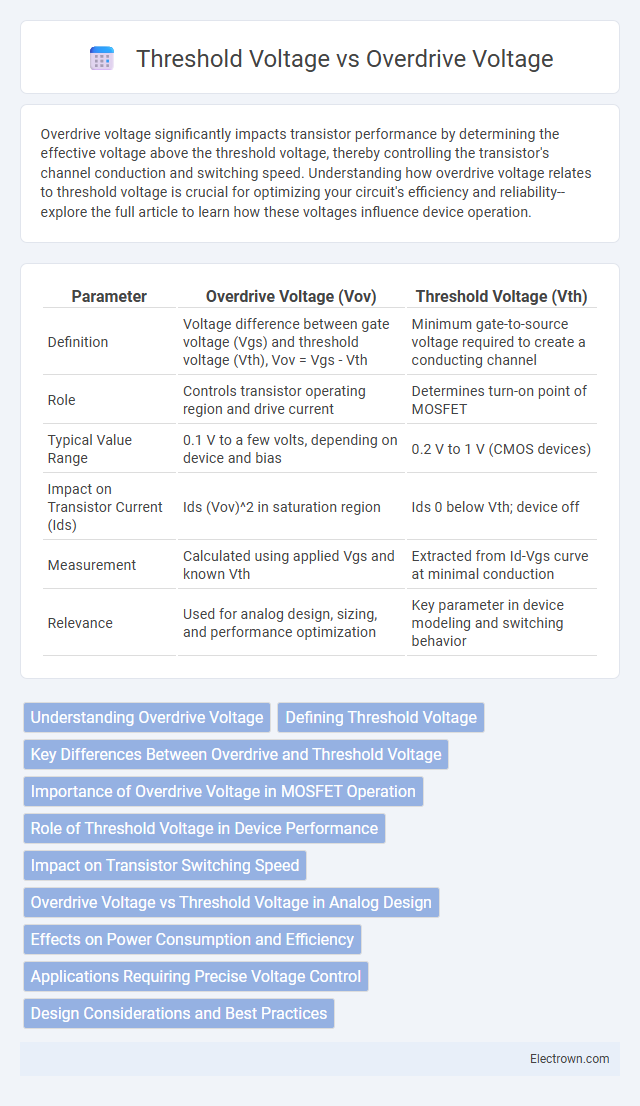Overdrive voltage significantly impacts transistor performance by determining the effective voltage above the threshold voltage, thereby controlling the transistor's channel conduction and switching speed. Understanding how overdrive voltage relates to threshold voltage is crucial for optimizing your circuit's efficiency and reliability--explore the full article to learn how these voltages influence device operation.
Table of Comparison
| Parameter | Overdrive Voltage (Vov) | Threshold Voltage (Vth) |
|---|---|---|
| Definition | Voltage difference between gate voltage (Vgs) and threshold voltage (Vth), Vov = Vgs - Vth | Minimum gate-to-source voltage required to create a conducting channel |
| Role | Controls transistor operating region and drive current | Determines turn-on point of MOSFET |
| Typical Value Range | 0.1 V to a few volts, depending on device and bias | 0.2 V to 1 V (CMOS devices) |
| Impact on Transistor Current (Ids) | Ids (Vov)^2 in saturation region | Ids 0 below Vth; device off |
| Measurement | Calculated using applied Vgs and known Vth | Extracted from Id-Vgs curve at minimal conduction |
| Relevance | Used for analog design, sizing, and performance optimization | Key parameter in device modeling and switching behavior |
Understanding Overdrive Voltage
Overdrive voltage is the difference between the gate-to-source voltage (V_GS) and the threshold voltage (V_TH) of a transistor, crucial for determining the device's conduction level. It directly affects the drain current and switching speed, making it a key factor in designing efficient MOSFET circuits. Understanding your transistor's overdrive voltage helps optimize performance by ensuring sufficient drive strength without exceeding safe operating limits.
Defining Threshold Voltage
Threshold voltage is the minimum gate-to-source voltage required to create a conductive channel between the source and drain terminals of a MOSFET, enabling current flow. This parameter is critical for determining the switching behavior and power efficiency of transistors in integrated circuits. Understanding your device's threshold voltage helps optimize overdrive voltage, which is the difference between the gate voltage and this threshold, directly impacting transistor speed and performance.
Key Differences Between Overdrive and Threshold Voltage
Overdrive voltage is the voltage applied to a transistor's gate beyond its threshold voltage, directly influencing the device's drive current and switching speed, while threshold voltage is the minimum gate-to-source voltage needed to create a conductive channel between the source and drain. Overdrive voltage impacts the transistor's operational efficiency and switching frequency, whereas threshold voltage determines the device's turn-on condition and power consumption. Understanding these differences is crucial in optimizing transistor performance, especially in low-power and high-speed digital circuits.
Importance of Overdrive Voltage in MOSFET Operation
Overdrive voltage (V_ov) is the difference between the gate-to-source voltage (V_gs) and the threshold voltage (V_th) in a MOSFET, directly impacting its conduction state and current flow. Precise control of overdrive voltage is crucial for optimizing the MOSFET's drive strength, allowing for efficient switching and amplification in analog and digital circuits. Higher overdrive voltage enhances carrier mobility and reduces channel resistance, thereby improving the device's transconductance and switching speed.
Role of Threshold Voltage in Device Performance
Threshold voltage (Vth) fundamentally determines the switching point of a transistor, directly impacting its speed and power consumption. Precise control of Vth is essential for optimizing overdrive voltage (Vov = Vgs - Vth), which defines the effective voltage driving the device into strong inversion and influences current flow and overall device efficiency. By balancing threshold voltage, designers can enhance transistor performance, achieving lower power usage while maintaining sufficient drive strength for high-speed applications.
Impact on Transistor Switching Speed
Overdrive voltage directly influences transistor switching speed by enhancing the drive current beyond the threshold voltage, enabling faster channel formation and quicker transition between ON and OFF states. Increasing overdrive voltage reduces the effective delay time in metal-oxide-semiconductor field-effect transistors (MOSFETs) by accelerating carrier velocity and lowering the gate-to-source voltage margin needed for conduction. Optimizing overdrive voltage relative to threshold voltage is critical for high-speed digital circuits, balancing power consumption against switching efficiency.
Overdrive Voltage vs Threshold Voltage in Analog Design
Overdrive voltage (V_OV) in analog design represents the difference between the gate-to-source voltage (V_GS) and the transistor threshold voltage (V_TH), directly influencing the transistor's operating region and current drive capability. It is crucial for optimizing the trade-off between power consumption and speed, as higher overdrive voltage increases drain current but also leads to higher power dissipation and reduced gain. Precise control of V_OV relative to V_TH enables enhanced linearity and performance stability in analog circuits such as amplifiers and analog-to-digital converters.
Effects on Power Consumption and Efficiency
Overdrive voltage, defined as the difference between the gate-to-source voltage and the threshold voltage, directly impacts transistor switching speed and power consumption. Higher overdrive voltage increases drive current, reducing delay but causing higher dynamic power due to increased switching activity and leakage currents. Optimizing your circuit involves balancing overdrive voltage to minimize power consumption while maintaining efficiency and desired performance levels.
Applications Requiring Precise Voltage Control
Overdrive voltage (V_ov) closely relates to the difference between gate voltage and threshold voltage (V_th), making it crucial for applications requiring precise voltage control such as analog circuits and sensor interfaces. Accurate control of V_ov enables improved transistor switching performance and linearity, enhancing overall circuit stability and sensitivity. Your designs benefit from carefully balancing overdrive voltage to maintain consistent operation parameters in sensitive environments.
Design Considerations and Best Practices
Design considerations for Overdrive Voltage versus Threshold Voltage emphasize optimizing transistor switching performance and power efficiency in integrated circuits. Maintaining an overdrive voltage significantly above the threshold voltage enhances drive current and switching speed, but excessive overdrive increases power consumption and device stress, necessitating careful balance. Best practices include precise threshold voltage control through device doping and process variations, along with adaptive biasing techniques to dynamically adjust overdrive voltage for varying operational conditions.
Overdrive Voltage vs Threshold Voltage Infographic

 electrown.com
electrown.com